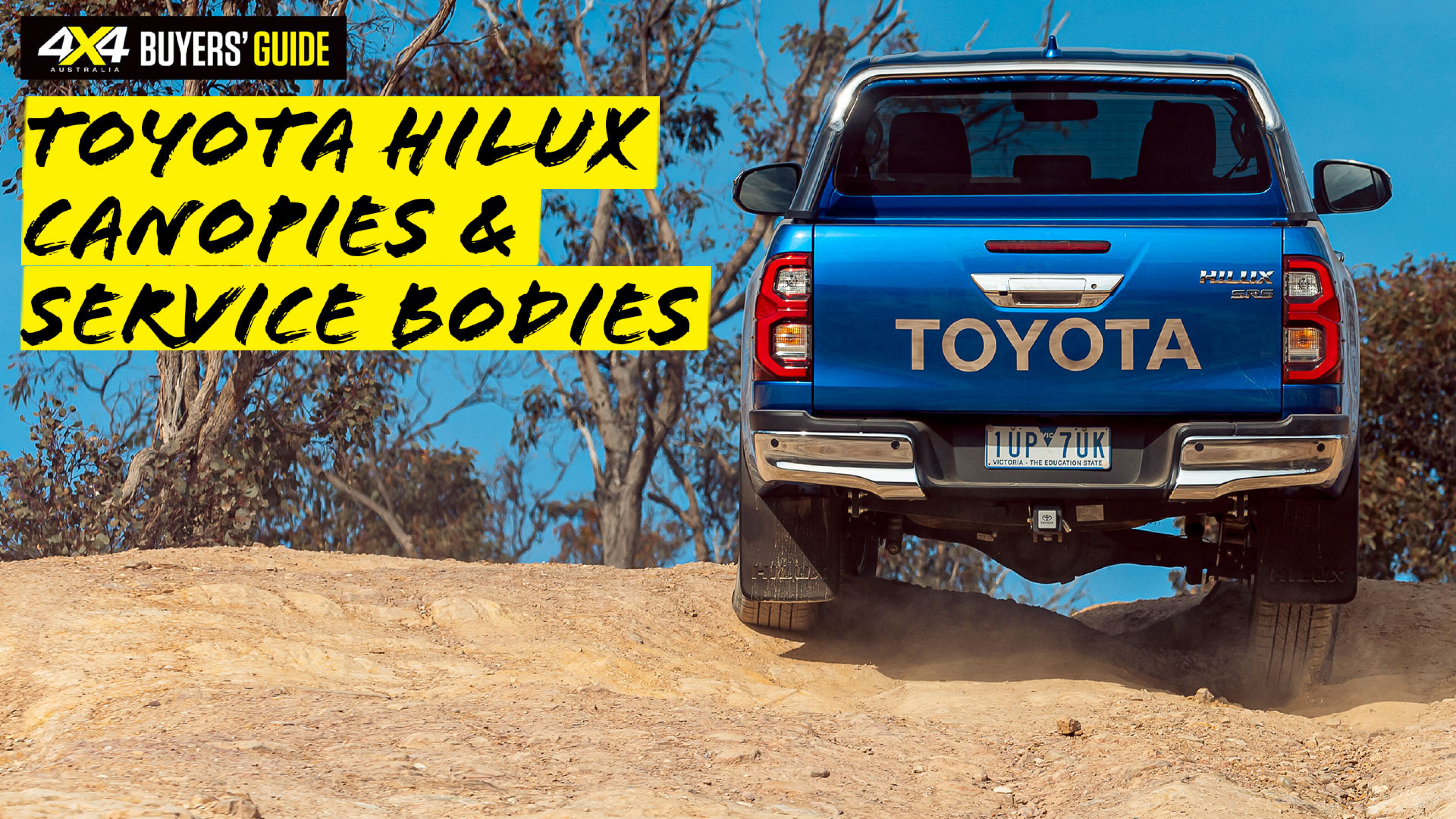
Whether you’re a tradie or a weekend warrior, the ability to throw gear in the back and keep anything wet or smelly outside of the cabin is a huge benefit.
The problem, though, is that tubs and trays offer little in the way of weather protection or security. The solution is a canopy or service body, of course. The modular design of these aftermarket units allows owners to tailor a set-up that best suits their lifestyle and the gear they're carrying.
- What it is: The HiLux comes with a tub or cab-chassis. A canopy sits on top of the tub, while a service body sits on top of the chassis and includes a tray and canopy combined. A canopy on a tub is typically a clamp-on option that can be removed, but a service body is a permanent fixture.
- Why you need it: An open tub or tray exposes gear to the elements and offers no security. A canopy or service body offers weather protection and the ability to keep cargo secure.
- Buying tips: A canopy is cheaper and lighter than a service body, but a service body offers more interior storage space and easier access via large doors on the sides. Canopies might cost $3000, but a decent service body might cost $12,000 with extras running it over $20,000. If building an off-road tourer, ensure you buy one designed for off-roading and not a tradie version. Almost all service body and canopy makers will have a product for the HiLux, so there are so many we can’t list them all. We’ve listed a few to start with.
- What to Look For: Here’s what to consider when deciding between a canopy and a service body.
- Do you want to remove it occasionally or will it be a permanent fixture?
- What’s your budget? Costs can quickly add up, regardless of which one you choose.
- When shortlisting possible options, find out what each one weighs. Some service bodies can be heavy, which eats into payload.
- There’s nothing more annoying than chasing a dust or water leak, so do your research.
- If space is your number one consideration, then go with a service body.
Canopies and service bodies are a fantastic way to transform your ute into an ultimate tourer. Once you have the basic shell, your options are limited only by what you can dream up … and what you can fit in there. Alternatively, select a tried and tested unit from a supplier, already kitted out and ready to go.
Whatever you choose, you’ll be well-equipped to hit the dirt and start exploring.
JUMP AHEAD
| Material | Finish | Weight | Load Rating | |
|---|---|---|---|---|
| ARB Ascent canopy | UV-stable ABS thermoplastic | Colour-coded | 60-70kg | 100kg (dynamic)350-400kg (static) |
| Ironman Pinnacle 2 | Heavy-duty vinyl ester fibreglass | Colour-coded | 100kg | 90kg (dynamic) |
| EZtoolbox | Aluminium | Black or white | 120kg | Not specified |
| Trig Point | Combined steel and aluminium | Colour-coded | 260kg | 300kg |
ARB Ascent canopy
The flagship of the ARB range, the Ascent Canopy features UV-resistant thermoplastic and a three-year/60,000km warranty, meaning this is a long-term investment. Added features like vents to provide positive canopy pressure and lift-up side windows improve the user experience.
Specifications
- Material: UV-stable ABS thermoplastic
- Finish: Colour-coded
- Weight: 60-70kg (approx.)
- Load Rating: 100kg (dynamic); 350-400kg (static)
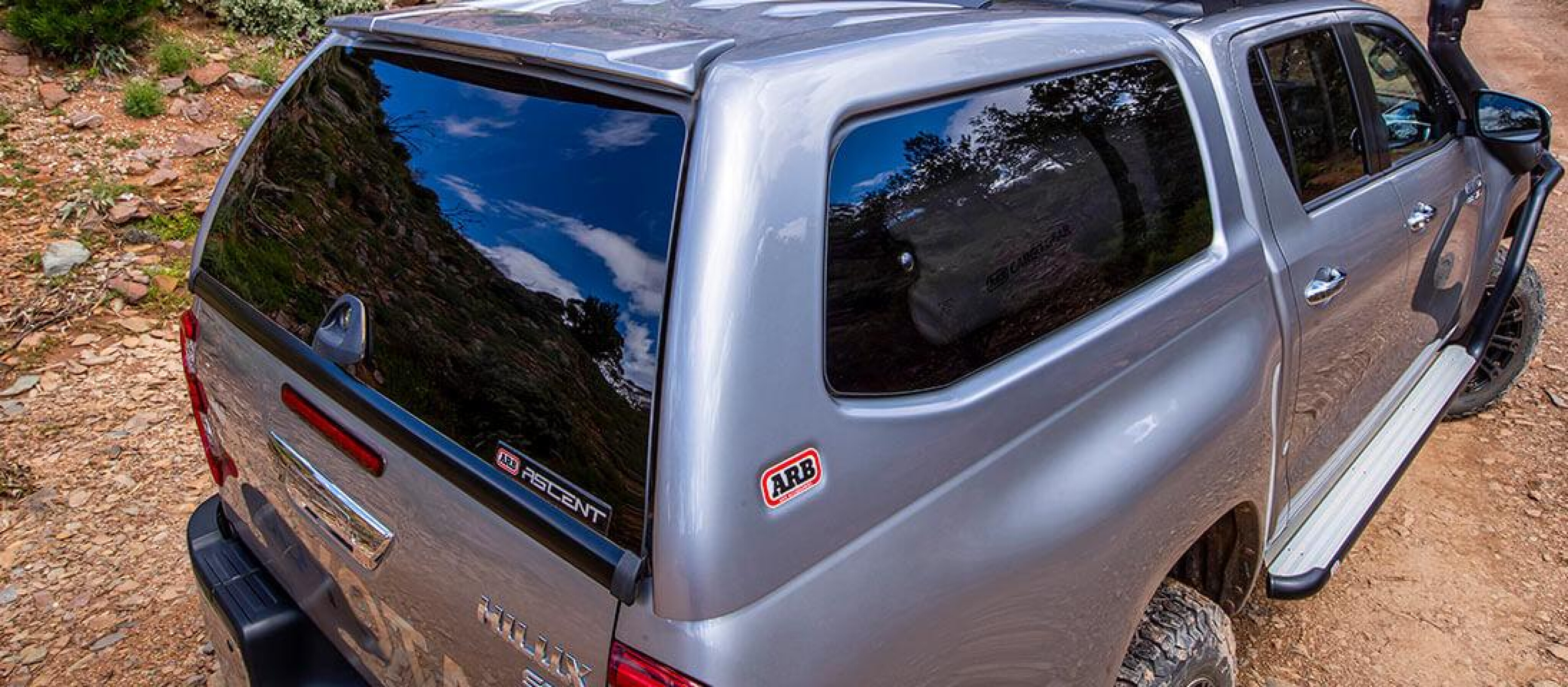
Pros
- Side lift-up windows for easy access
- Integrated central locking
- Front-facing vent to create positive pressure and reduce dust ingress
Cons
- With 28 per cent tinting, say goodbye to rear visibility at night
- Pricey
Ironman 4x4 Pinnacle 2 canopy
Sleek lines are the standout feature of this canopy from Ironman 4x4. It may be missing some of the features of high-end canopies, but it’s also missing some of the dollars from the price tag. The Pinnacle 2 is far from a low-budget option in terms of quality, but if positive pressure air vents and 100kg roof loads seem excessive, then have a look at this unit.
Specifications
- Material: Heavy-duty vinyl ester fibreglass
- Finish: Colour-coded
- Weight: 100kg (approx.)
- Load Rating: 90kg (dynamic)
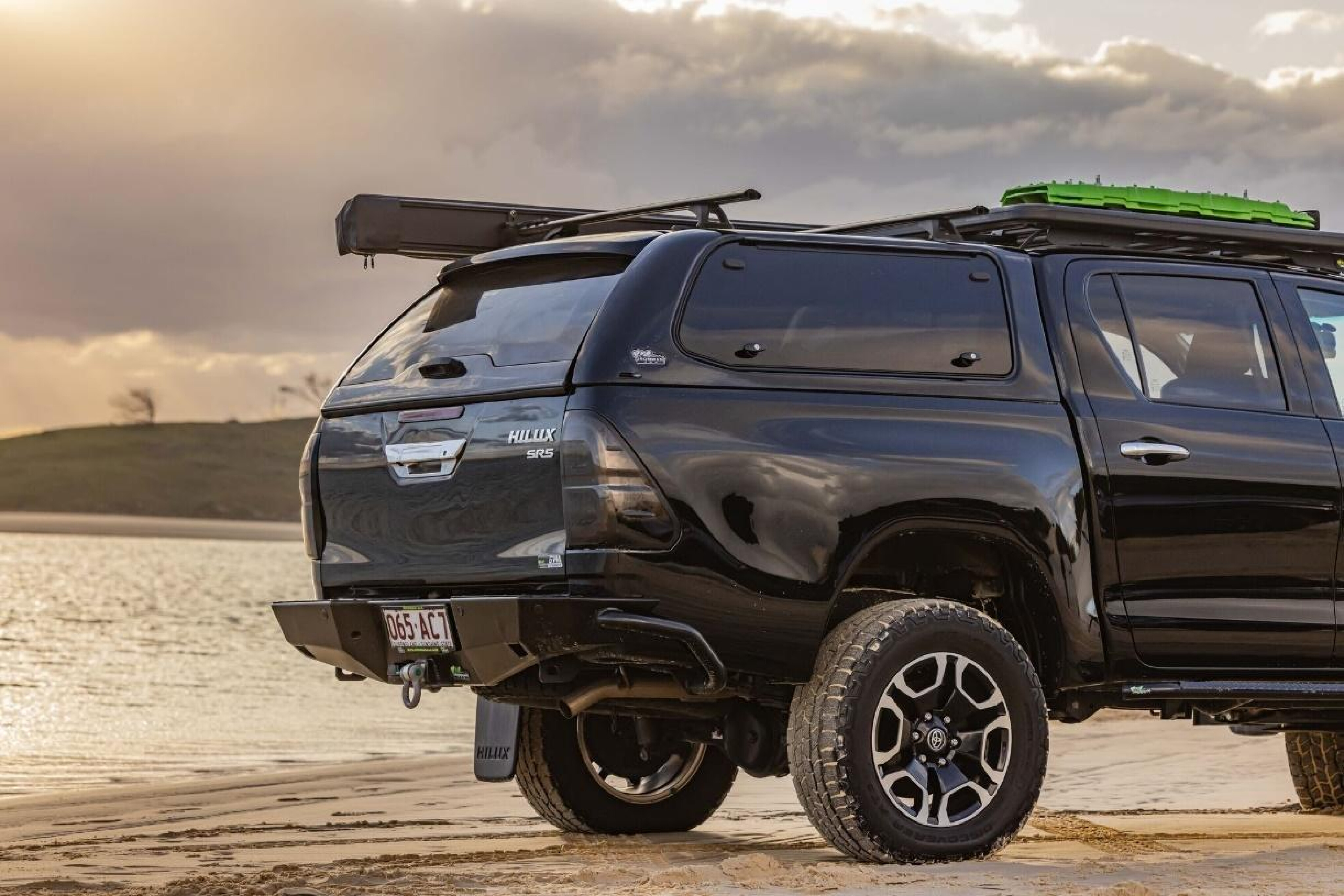
Pros
- Side lift-up windows for easy access
- Good value
- Wide drain design to reduce blockages
Cons
- Central locking on the rear door only
- Side window locks protrude out slightly
EZToolbox service body
Aluminium construction means the EZtoolbox service body is relatively lightweight and doesn’t eat into all-important payload. Complete with undertray toolboxes and a trundle drawer, this is the complete storage solution. The tapered under-tray boxes mean departure angle is compromised, though.
Specifications
- Material: Aluminium
- Finish: Black or white powdercoated
- Weight: 120kg (approx.)
- Load Rating: Not stated
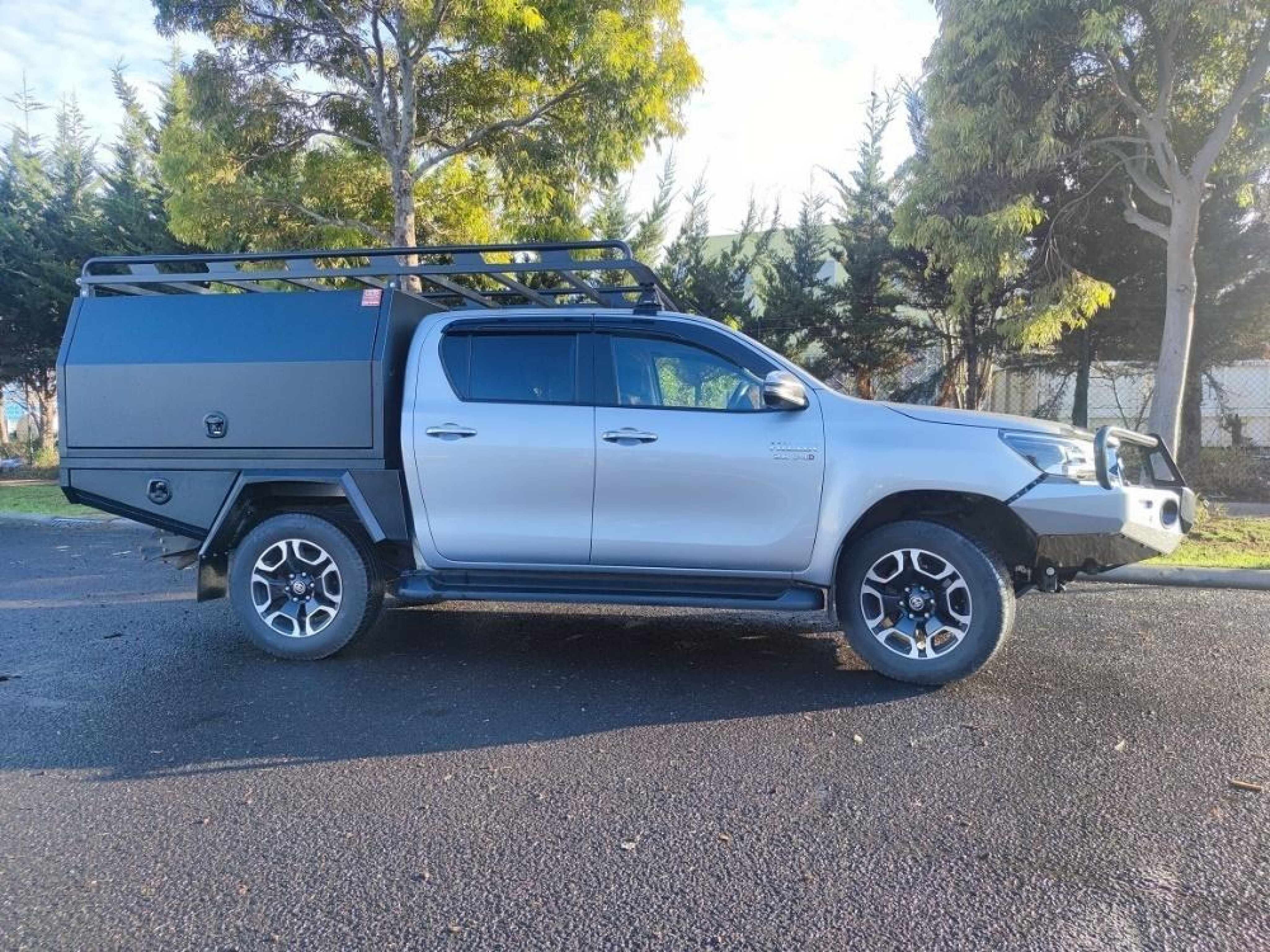
Pros
- Lifetime structural warranty and two years on toolboxes
- Included spare wheel, jerry can holder and ladder
- Included under-tray toolboxes and trundle drawer
Cons
- 10-12 week lead time for build
Trig Point service body
Its combined aluminium and steel construction make it both strong and lightweight in equal measure. This service body from Trig Point is a more premium option and includes a rear bar to protect the tray and under-tray toolboxes, filtered air vents to cool the canopy, and a built-in roof rack.
Specifications
- Material: Combined steel and aluminium
- Finish: Colour-coded
- Weight: 260kg (approx.)
- Load Rating: 300kg
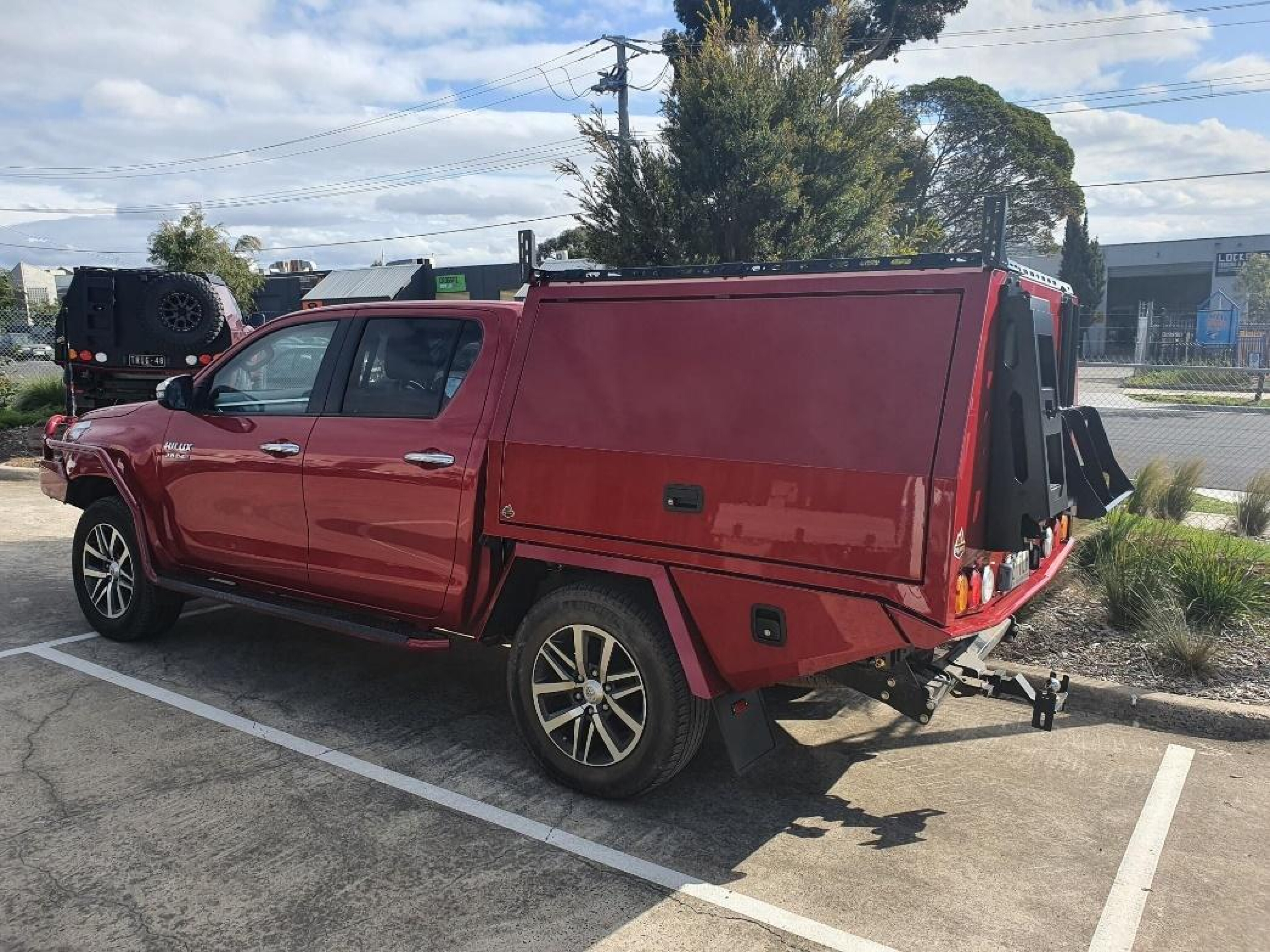
Pros
- Integrated roof rack
- Flush floor with no lips, to make loading easy
- Central locking
Cons
- Price starting to get up there
Buyers' guide for canopies
The standard ute tub is a basic bit of gear, but add a tub liner, canopy and a drawer system, and your ute becomes an ideal weekend adventurer or tourer.
A canopy adds security, protects your gear, and allows you to carry loads on top. Whether the load’s a rooftop tent, a load of timber for work or a second spare, choosing the right canopy is important. Which canopy you choose depends on what you plan to use it for.
As with any piece of aftermarket gear added to a 4x4 build, it’s important to first establish what your intended purpose is: Are you a tradie looking to keep your tools safe? Perhaps you’re planning your next Red Centre run?
Once that’s established and you’ve started the long, tedious process of browsing aftermarket catalogues, there are a handful of essential elements to keep in mind including materials, construction, fitment, roof-load capacity, access, accessories and aesthetics, to name a few.
As with any off-road purchase, ensure the supplier has a quality reputation and can back its product with aftermarket support and a substantial warranty.
Load rating
By installing a canopy, like a tub topper, and then loading it with tools and/or gear for your next camping trip, the kilograms will begin to rise. This is why it’s critical to always monitor your vehicle’s weight and not overload it.
Most canopies will easily cope with a couple of lightweight kayaks. On the other hand, a rooftop tent is heavy amd will need a sturdy canopy with a high load rating.
And you need to consider roof loading based on type of travel. As a rule of thumb, off-road loading should be 50 to 75 per cent of the rated (on-road) capacity. Most canopy manufacturers specify on-road roof loading.
A few quote both static and dynamic loading. Static loading is a useful number when you fit a rooftop tent, roof platform or similar. It tells you how much weight the canopy will take when you’re parked up, with you and your partner sleeping in it. Dynamic loading is the load rating when travelling.
Is dynamic loading the on-road or the off-road rating? It depends on what figures the manufacturer quotes. Without contacting them directly, it’s impossible to tell. Unfortunately, there’s no standard for specifying loadings.
If in doubt, assume dynamic loading is the on-road capacity, then down-rate the figure for off-road use. Why derate for off-road travel? Because twisting forces, vibrations and rough conditions mean your canopy will be subject to a whole lot of extra loads that will try to rip your canopy apart.
The 50 to 75 per cent load rating is a wide range. Use common sense here. If you’re planning on a trip on rough outback roads or a full-on crawl over the wild tracks of the Victorian High Country, then go with 50 per cent. On the other hand, 75 per cent will be okay if you’ll be driving along well-maintained gravel roads.
Say the canopy’s roof loading is 100kg, then you’re potentially down to 50kg when off-road … less the weight of the roof bars and roof basket or roof platform. That’s maybe a kayak or a couple of swags and no more. Forget about carrying a spare tyre or fitting a rooftop tent.
Generally, a steel or aluminium canopy will have a higher load rating than a fibreglass canopy, but not always. The load rating depends on how the canopy’s made and whether it has an internal frame.
Materials
Canopies come in a variety of shapes and sizes and are constructed using different materials, with your budget typically dictating what path you’ll head down when the time comes to swipe the credit card. Typically, you’ll have to choose between stainless steel, fibreglass, aluminium/metal, or a form of plastic construction.
A quick glance through the canopies we’ve included in our list reveals a wide variety of materials: fibreglass, ABS thermoplastic, mild steel, stainless steel, and aluminium.
Fibreglass is more the traditional material which canopies were made from. They generally have additives to increase strength and UV resistance. The biggest advantage of fibreglass is they’re lightweight. However, manufacturers are now making aluminium and even steel canopies at equivalent weights, qnd their roof loadings are usually (but not always) double or triple that of fibreglass equivalents.
The big advantage of steel or aluminium over fibreglass is window-opening sizes. Due to steel’s inherent strength, window mullions can be thinner. So the openings are larger, making them easier to access and easier to pack.
Keep in mind, however, that metal fatigue is more prominent in aluminium than stainless steel, so aluminium may have a tendency to crack more easily over time. Stainless steel is an extremely strong and versatile material and, contrary to popular belief, isn’t as heavy as you’d think.
One positive of fibreglass and ABS over steel are their insulation properties. As a rule, they don’t transmit as much heat into the canopy as steel and aluminium.
Security
One of the biggest benefits of a canopy is knowing the gear in the tub is safe, and that’s why you should pay attention to the window latches. Look closely at canopies with T-handles, as they can easily be pried open.
We had folding T-handles on a set of toolboxes once, and after several thousand kilometres of corrugations, they decided to snap all by themselves. It’s not a great feeling when you glance in the mirror and see your gear falling out on to the road.
The best latch is a compression latch, as they’re highly reliable and difficult to break in to.
Central locking
Most premium canopies offer central locking. Some include all windows, while others only have central locking on the rear window. Central locking is super-convenient, no doubt, but consider where the canopy will spend most of its life.
We’ve seen more than one canopy central-locking system fail in rough, dusty conditions. Sometimes they fail-locked, other times they won’t lock at all. Either one is particularly frustrating, especially when the keyhole’s plugged up with red dust.
If your ute will be spending its life traversing back blocks, central locking is probably not such a good idea. But if your ute spends most of its life in the suburbs, then central locking is a no-brainer.
Clamping or bolting?
Some canopies clamp to the tub lip with multiple clamps; others require bolts through the tub lip, which means you need to drill into the tub The strongest canopies tend to brace down to the floor of the tub - this way the canopy doesn’t rely on the sides of the tub for strength or support.
Some of you will be okay with drilling holes in the tub’s top lip, while others would rather the less-invasive clamping method - it depends on what you’re comfortable with. Either way, look for canopies which extend down slightly past the top of the lip on the outside faces, as this helps keep the rain and the dust out.
Other considerations
An air hatch is a useful addition to any canopy. It pressurises the canopy, minimising the amount of dust ingress, and it also helps keep the canopy cooler on hot days. Another consideration is whether the canopy is lined, as this adds a touch of luxury and helps to insulate it from cold and heat.
Internal lights are essential. Some canopies have the same system as vehicle’s internal lights - they switch on when the rear door opens. Some lights have their own battery, while others are powered from the vehicle.
If your canopy has the option of internal lights or central locking, check where the electrics connect. This can mean the difference between a simple installation and the need to run extra cabling to the starting battery.
How we review products
4X4 Australia has been reviewing four-wheel drive vehicles and aftermarket products for more than 40 years.
When looking for the best accessories for your make and model of 4WD, there are some things essential to making sure you have the best off-roading experience.
When we compare products, here are some of the things we consider:
- Warranty
- Build quality
- Value for money
- Time and ease to set-up/install
- Weight
- Fit and finish
- How well it gets the job done
- What materials they’re made from
- Corrosion/UV resistance
- Coatings
- Compatibility with other accessories
- Compliance with ADRs and vehicle safety systems
- Country of manufacture
- Load ratings, to determine what's the best product across each price point.
We also consider user reviews and our own experience with these products to make sure our recommendations are for the best on the market.
Disclosure: When you buy through our links, we may earn a commission. We also include products that we do not earn a commission from.

COMMENTS